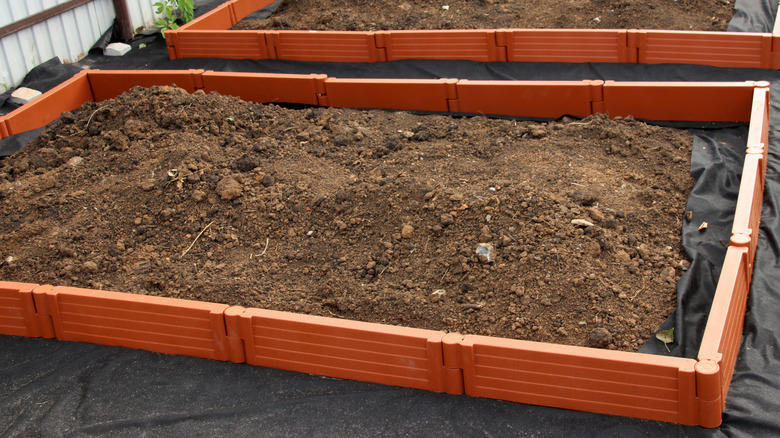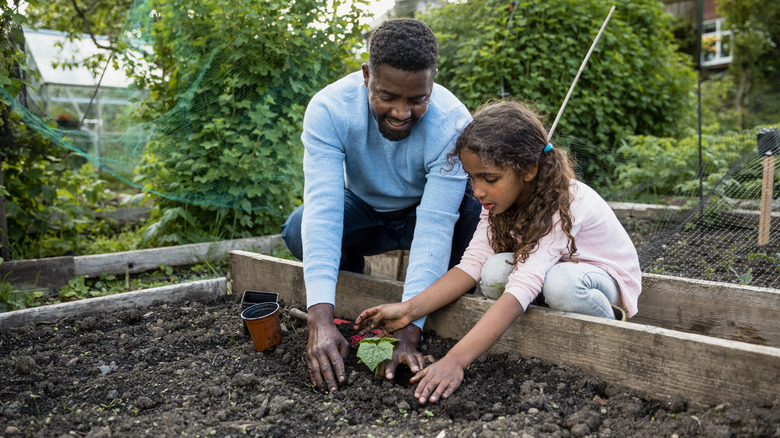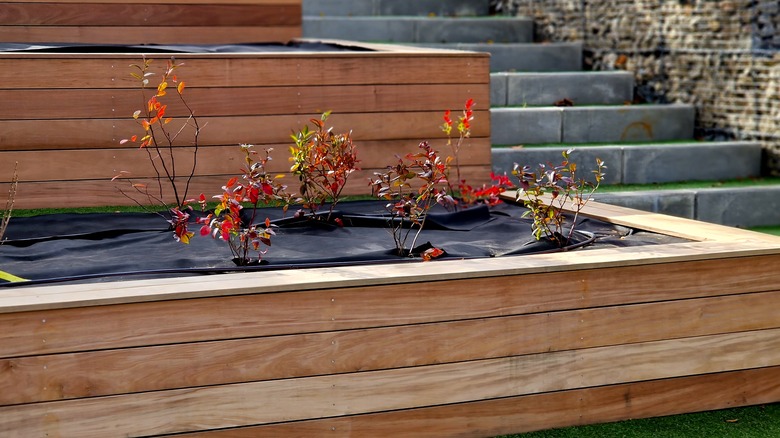What You Should Know Before Lining Your Raised Garden Beds With Plastic
When you build a raised bed, you have the chance to create optimal conditions for both yourself and the plants you are growing within. For instance, you can completely control the design of your raised garden bed, from the dimensions to the soil composition. To make your raised bed as beneficial as possible for all the humans and plants involved, lining the box with some sort of barrier to discourage weeds is a good preventative measure.
Some gardeners opt for cardboard, while others use sheets of cloth or permeable landscape fabric. Many people also choose impermeable plastic sheeting, which they lay down in the bed, cut holes in to add their plants, and then sometimes cover with mulch. This product is also sometimes placed underneath the soil. Before using this material, however, there are a few things you should know. While these sheets act as strong barriers to keep out weeds and heat up the ground, are convenient, and are relatively cheap, plastic sheeting contributes to plastic litter in the environment and can decrease your plants' health over time.
The list of pros and cons of using plastics is long, and the cons are growing constantly. Using plastic sheeting as a base for a vegetable patch or flower bed doesn't seem to fit with the ethos of natural gardening, yet some people still tout using it to line raised beds. Consider all the aspects of plastic weed barriers before deciding if they're the right choice for your garden.
Plastic sheeting is functional, convenient, and cheap
The biggest benefit of raised garden bed linings made from plastic is that they keep out stubborn weeds. Not only do they act as a barrier that weeds cannot grow through, but because they're typically a dark color, they also block out UV rays. Therefore, if there are any weed seeds trying to germinate beneath the sheeting, they won't be able to, as they won't be exposed to any sunlight. Plastic sheeting also helps soil heat up more quickly, which can be especially beneficial for those who live in colder climates, as it can give you a headstart on your growing season. It doesn't degrade as fast as other materials like cardboard and retains moisture better than other types of linings, too.
Furthermore, as is the case when using most plastics, convenience, ease of use, and the low cost are benefits as well. Plastic sheeting is sold in rolls for quick, convenient application, and the material itself is lightweight, making it easy to install in your garden. You can cut the sheets to size without any need to assemble lots of separate pieces into the raised bed, like you would with repurposed cardboard. It is also cost-effective, as an inexpensive roll can potentially line many garden beds. Because it can successfully keep weeds from growing, it could also save you money by acting as a substitute for weed killer so you hopefully won't have to purchase herbicides.
Plastic sheeting can harm the environment and your plants
However, introducing more plastic into the environment is frowned upon, and for good reason. If you want to make your home more eco-friendly, plastic sheeting is probably not for you. Despite its general durability, it will eventually break down, typically within a few years. Once it has broken down into smaller pieces, it inevitably litters the environment. Removing the degraded lining can also be a serious challenge, since it will very likely be in pieces rather than large sheets. Further, once removed, plastic sheeting pieces are typically thrown away, meaning that they end up in a landfill. In comparison, cardboard and other more natural options will degrade and add nutrients to the soil, benefitting your plants and the environment.
Aside from eco responsibility, plastic landscape fabric can diminish your plants' health by restricting the flow of water and air and exposing them to toxins that may damage the soil's chemistry. Although plastic sheeting is generally deemed food-safe by the FDA, possible leaching of toxins is still a concern. Further, while plastic can help with moisture retention in dry areas, it can also sometimes hold in too much moisture, leading to root rot. For plants to have healthy roots, they also need to have air circulation, and plastic may limit this necessary function.


